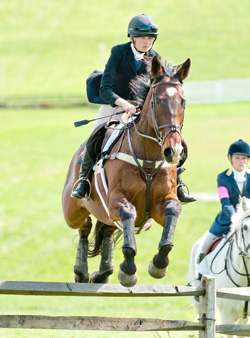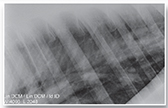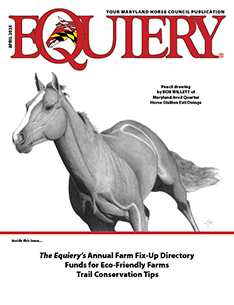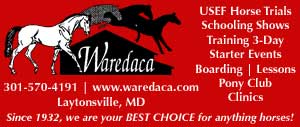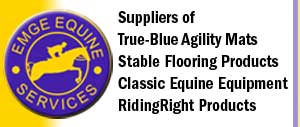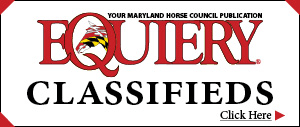(first appeared in the November 2014 issue of The Equiery)
by Katherine O. Rizzo
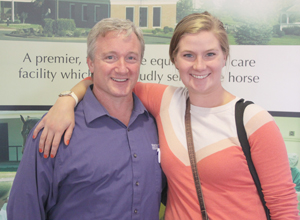
Interim director of Marion duPont Scott Equine Medical Center Dr. Mike Erskine (Damascus Equine Associates) with Carol Crabtree (Boyds) at EMC’s 30th anniversary celebration
When most people in Maryland have a horse emergency needing more care than their ambulatory veterinarian can handle, they either ship their horse north to New Bolton in Pennsylvania or south to Marion duPont Scott in Virginia. This might make it seem that Maryland as a state has no big equine hospital of its own, but that is not the case.
The Marion duPont Equine Medical Center (EMC), located at Morven Park in Leesburg, Virginia, is actually part of the Virginia-Maryland Regional College of Veterinary Medicine. It is a unique dual-state collegiate teaching hospital just a short drive from central Maryland and is funded jointly by Virginia and Maryland.
Since the facility opened its doors 30 years ago, hundreds of future equine veterinarians have walked its halls and made significant advancements in diagnostics and treatment in equine medicine. Students from all over the world come to EMC annually for its residency program and students from the college do internships at EMC and residencies at some of the country’s other top equine hospitals.
The hospital is highly regarded for both its emergency medicine and its surgical team as well as cutting-edge elective treatments, such as regenerative therapy, and top-of-the-line diagnostic tools, such as the only free-standing full body MRI in the region.
So exactly how do the college and EMC work together to create one of the country’s top equine research and treatment centers? Here are things you might not know about the school and hospital.
Cooperative Funding
Although specifics of budgets change each year, the Virginia-Maryland Regional College is the only school in the country in which two states work together to subsidize the program. The funds given by both states go directly into the college’s working budget and help offset the tuition costs so that both Maryland and Virginia residents are considered “in-state.”
Currently, in-state tuition is just over $21,000 a year while non-Maryland or Virginia residents pay just over $46,000 a year. The curriculum is a four-year program.
As for the hospital, about 65% of its operating budget comes from its clients with only 25% coming from the college. The rest of the funding comes from private donations.
The Students
The college currently has 120 students with about 30 students annually hailing from Maryland and 50 students annually from Virginia. Forty students come from “at large,” meaning out of state. Dr. Michael Erskine, interim director of EMC, stated that the ratio of Maryland to Virginia students has been the same since the program first started 30 years ago but the at-large student body has increased over the years.
Interestingly, the majority of the student body is actually on the small animal track with only about 19 students a year declaring equine medicine as their desired field. Most students declare their focus after the first year of school.
Dr. Erskine commented that these equine students “are basically self-selected. They have all grown up around horses and are very experienced with basic horse care before they even start their internships at the hospital.”
Interns, Residents and Research
The EMC attracts graduates to its residency program from all over the world. These are the students who will become future specialists and come to EMC to study with some of the best surgeons in the country and perform clinical research. They provide a comprehensive service for the hospital’s clients and over the years, advancements in colic surgery and regenerative medicine, as well as in other areas, have been a result of the program. Most of the interns and residents will gather adequate knowledge at EMC, undergo thorough training in practice, and go on to find productive equine veterinary jobs in different parts of the world.
Currently there are two interns at EMC and three residents. Two are surgical residents and one is focusing on internal medicine.
The VA-MD Regional College feeds students into the residency program as well and also sends its students to other hospitals throughout the country. “It is a very open door sort of program, which is very beneficial for everyone,” Dr. Erskine explained.
Diagnostic Tools
Probably one of the biggest benefits of bringing a horse to EMC for lameness issues is its wide array of diagnostic tools including its standing MRI suite. EMC offers the only open magnet full body MRI in the region, installed in 2004. This allows a horse to be scanned with basic sedation while standing, versus complete anesthesia.
The hospital also has both digital and computed radiography as well as orthopedic, abdominal and cardiac ultrasounds. Upper airway and gastroscopic endoscopy is offered as well as dynamic endoscopy, which allows veterinarians to view a horse’s airway while it is being exercised.
In addition to the MRI, EMC has a nuclear bone scan suite (nuclear scintigraphy) and can perform laparoscopy, arthroscopy, fluoroscopy and electrodiagnostics. And that is just what they currently have.
EMC is currently preparing to offer the region’s first equine CAT scan services. “We have the device in hand but are still looking for more funding in order to have it fully installed and ready for use by early 2015,” Dr. Erskine reported. As with the MRI, the CAT scan can be used while a horse is standing under basic sedation.
Equine Treatments
When most people hear their veterinarian say “Leesburg,” they immediately think surgery. But EMC actually offers several outpatient procedures and treatments as well. Laser surgery is one of the more recent developments at EMC. It is a highly refined and focused light source that can deliver energy in a very precise way. “Most commonly it is used for removing skin tumors or for upper airway surgery,” Dr. Erskine stated.
Stem cell transfer through regenerative therapies is also a newer cutting edge technology that is being perfected at EMC. The facility has a full state-of-the-art regenerative medicine laboratory.
They can also use shockwave therapy, IRAP, mesotherapy and alternative medicine treatments such as acupuncture and chiropractic work.
The Barns
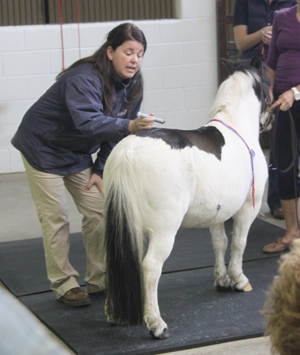
Dr. Anne Derochers explains acupuncture, which is one of the many treatments offered at EMC, during a free seminar at EMC.
The facility has grown considerably through the years. It started with just two 12-stall barns. There were times in EMC’s history where they were full and had to turn away patients. Thus more barns and stalls have been added in response to the demand.
Now, the facility has 51 stalls, most of them climate-controlled, including five intensive care stalls and the eight isolation stalls. The stalls are spread out among four barns with two main medical wards, an isolation barn and a temporary housing barn for outpatient use.
The barns are regularly monitored 24 hours a day, seven days a week by a team of nurses and technicians. Students, interns and residents assist the professional staff as needed.
The Patients
The majority of the equines that come through EMC are actually there for diagnostics or elective procedures and treatments. About 40% come from Maryland with the other 60% coming from Virginia or nearby states such as West Virginia and North Carolina. Over the past 30 years, EMC has treated over 55,000 horses.
“Most people come to EMC because of the extremely high level of expertise we have to offer as well as the amount of comprehensive imaging and diagnostic tools we can use,” said Dr. Erskine. This makes EMC a one-stop shop in many ways with everything your horse could possibly need housed under one roof.
The most common cases EMC tends to see are emergency colic surgeries (sometimes as many as three colic surgeries in a day), sick foals, other emergency medicine procedures and lameness exams.
Farrier Shop
There is a farrier shop at EMC headed by Paul Goodness who is on-site two to three days a week. The shop has two stalls and two work stalls and everything a farrier would need to assist veterinarians in consultations with clients.
The Staff

Dr. James Brown shows onlookers one of the padded rooms where horses are anesthetized before surgery.
It takes more than just a village to keep EMC running. In addition to its students, interns and residents, EMC has a technical and nursing staff of 36 people. There are on-site surgeons, two internal medicine veterinarians and five house officers. There are also 12 administrative staff members.
There are four licensed veterinarian technicians who act as case coordinators for the hospital. These positions were just created this past year so that when a patient enters the hospital, there is one person who coordinates everything that the horse needs for its entire stay from start to finish.
Out of the current roster of veterinarians, four have come through the EMC system during their education in some way. Surgeons Kenneth Sullins, DVM and Nathaniel White, DVM both graduated from VA-MD Regional College. Martin Furr, DVM (internal medicine) did his residency at EMC and James Brown, BVSc did his surgical residency at EMC.
Who Was Marion duPont Scott?
Although Marion duPont Scott was born in Delaware, she spent much of her childhood in England. Here in the States, she called Virginia’s Montpelier (once owned by President James Madison’s family) home but also established Holly Hedge in Camden, South Carolina, now know as the Camden Training Center. She went on to become one of the most influential horsewomen in the Virginia-Maryland area.
Her interest in horses was broad, as she was a show rider and foxhunter and also owned both flat track and steeplechase racehorses. In 1915, she was the first woman to ride astride at the National Horse Show at Madison Square Garden in New York. With her brother, William duPont, Jr., she developed several racing venues including Delaware Park and Fair Hill, home of the National Steeplechase Association headquarters and now the Fair Hill Natural Resources Management Area.
Probably the most well-known horse to come through her racing stables was Battleship (son of the great Man o’ War), who became the first American-bred and American-owned horse to win the Grand National Steeplechase in Aintree, England in 1938. He is the only horse in history to win both the American Grand National and the English Grand National. Annapolis was another Man o’ War son in her stables.
Her horse Mongo was named 1963 American Champion Male Turf Horse. The Eclipse Awards were then created in 1971 and duPont Scott won two; the 1972 American Champion Steeplechase Horse with Soothsayer and the American Champion Older Female Horse with Proud Delta in 1976. She also earned the Thoroughbred Breeders of Kentucky Award in 1973 and the Joe Palmer Award in 1981 from the National Turf Writers Association.
In 1981 she donated $4 million to Virginia Polytechnic Institute and State University to create the Equine Medical Center. Marion duPont Scott died on September 4, 1983.

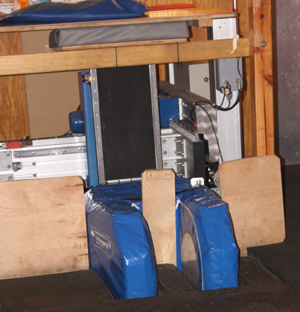
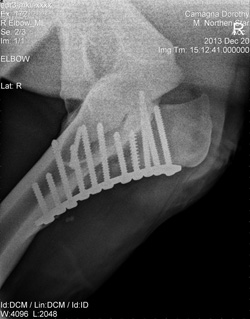
 The six-year-old off-the-track Thoroughbred had just celebrated a year off the track and an introduction to eventing at the Redland Hunt Pony Club Combined Test in Olney. Taking home a yellow ribbon and enough smiles and pictures to last for months, it seemed like the month of April was destined to start the best year ever for me and my partner in crime, Airy.
The six-year-old off-the-track Thoroughbred had just celebrated a year off the track and an introduction to eventing at the Redland Hunt Pony Club Combined Test in Olney. Taking home a yellow ribbon and enough smiles and pictures to last for months, it seemed like the month of April was destined to start the best year ever for me and my partner in crime, Airy.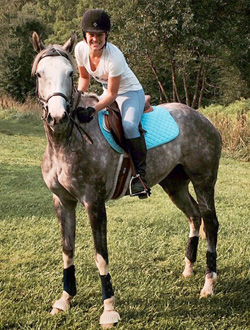
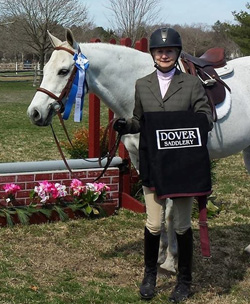
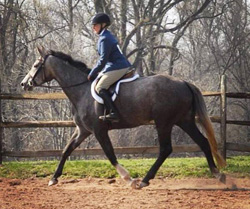 On behalf of Jack Louth, Property Manager at Cedar View Farm and myself as Barn Manager, I’d like to share our EMC success story about our homebred filly, SuperStar. She was featured in Equus Magazine last October regarding her miraculous recovery from Cervical Vertebral Osteomyelitis/Meningitis, which in normal cases would be a death sentence.
On behalf of Jack Louth, Property Manager at Cedar View Farm and myself as Barn Manager, I’d like to share our EMC success story about our homebred filly, SuperStar. She was featured in Equus Magazine last October regarding her miraculous recovery from Cervical Vertebral Osteomyelitis/Meningitis, which in normal cases would be a death sentence.